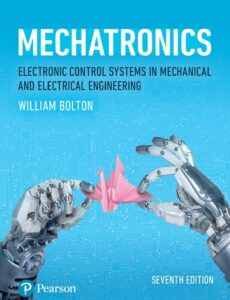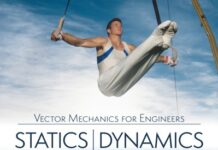| Book Name: | Mechatronics: Electronic Control Systems in Mechanical and Electrical Engineering |
| Category: | Mechanical Books |
| Language: | English |
| Format: | |
| Free Download: | Available |
Mechatronics: Electronic Control Systems in Mechanical and Electrical Engineering

Book Description :
The integration of electronic engineering, mechanical engineering, control, and computer engineering – Mechatronics – lies at the heart of the innumerable gadgets, processes, and technology without which modern life would seem impossible. From auto-focus cameras to car engine management systems and from state-of-the-art robots to the humble washing machine, Mechatronics has a hand in them all.
Table of contents :
Part I: Introduction
Chapter one: Introducing mechatronics
Objectives
1.1 What is mechatronics?
1.2 The design process
1.3 Systems
1.4 Measurement systems
1.5 Control systems
1.6 Programmable logic controller
1.7 Examples of mechatronic systems
Summary
Problems
Part II: Sensors and signal conditioning
Chapter two: Sensors and transducers
Objectives
2.1 Sensors and transducers
2.2 Performance terminology
2.3 Displacement, position and proximity
2.4 Velocity and motion
2.5 Force
2.6 Fluid pressure
2.7 Liquid flow
2.8 Liquid level
2.9 Temperature
2.10 Light sensors
2.11 Selection of sensors
2.12 Inputting data by switches
Summary
Problems
Chapter three: Signal conditioning
objectives
3.1 Signal conditioning
3.2 The operational amplifier
3.3 Protection
3.4 Filtering
3.5 Wheatstone bridge
3.6 Pulse modulation
3.7 Problems with signals
3.8 Power transfer
Summary
Problems
Chapter four: Digital signals
objectives
4.1 Digital signals
4.2 Analogue and digital signals
4.3 Digital-to-analogue and analogue-to-digitalconverters
4.4 Multiplexers
4.5 Data acquisition
4.6 Digital signal processing
4.7 Digital signal communications
Summary
Problems
Chapter five: Digital logic
objectives
5.1 Digital logic
5.2 Logic gates
5.3 Applications of logic gates
5.4 Sequential logic
Summary
Problems
Chapter six: Data presentation systems
objectives
6.1 Displays
6.2 Data presentation elements
6.3 Magnetic recording
6.4 Optical recording
6.5 Displays
6.6 Data acquisition systems
6.7 Measurement systems
6.8 Testing and calibration
Summary
Problems
Part III: Actuation
Chapter seven: Pneumatic and hydraulic actuationsystems
objectives
7.1 Actuation systems
7.2 Pneumatic and hydraulic systems
7.3 Directional control valves
7.4 Pressure control valves
7.5 Cylinders
7.6 Servo and proportional control valves
7.7 Process control valves
Summary
Problems
Chapter eight: Mechanical actuation systems
objectives
8.1 Mechanical systems
8.2 Types of motion
8.3 Kinematic chains
8.4 Cams
8.5 Gears
8.6 Ratchet and pawl
8.7 Belt and chain drives
8.8 Bearings
8.9 Electromechanical linear actuators
Summary
Problems
Chapter nine: Electrical actuation systems
objectives
9.1 Electrical systems
9.2 Mechanical switches
9.3 Solid-state switches
9.4 Solenoids
9.5 Direct current motors
9.6 Alternating current motors
9.7 Stepper motors
9.8 Direct current servomotors
9.9 Motor selection
Summary
Problems
Part IV: Microprocessor systems
Chapter ten: Microprocessors and microcontrollers
objectives
10.1 Control
10.2 Microprocessor systems
10.3 Microcontrollers
10.4 Applications
10.5 Programming
Summary
Problems
Chapter eleven: Assembly language
objectives
11.1 Languages
11.2 Assembly language programs
11.3 Instruction sets
11.4 Subroutines
11.5 Look-up tables
11.6 Embedded systems
Summary
Problems
Chapter twelve: C language
objectives
12.1 Why C?
12.2 Program structure
12.3 Branches and loops
12.4 Arrays
12.5 Pointers
12.6 Program development
12.7 Examples of programs
12.8 Arduino programs
Summary
Problems
Chapter thirteen: Input/output systems
objectives
13.1 Interfacing
13.2 Input/output addressing
13.3 Interface requirements
13.4 Peripheral interface adapters
13.5 Serial communications interface
13.6 Examples of interfacing
Summary
Problems
Chapter fourteen: Programmable logic controllers
objectives
14.1 Programmable logic controller
14.2 Basic PLC structure
14.3 Input/output processing
14.4 Ladder programming
14.5 Instruction lists
14.6 Latching and internal relays
14.7 Sequencing
14.8 Timers and counters
14.9 Shift registers
14.10 Master and jump controls
14.11 Data handling
14.12 Analogue input/output
Summary
Problems
Chapter fifteen: Communication systems
objectives
15.1 Digital communications
15.2 Centralised, hierarchical and distributedcontrol
15.3 Networks
15.4 Protocols
15.5 Open Systems Interconnection communicationmodel
15.6 Serial communication interfaces
15.7 Parallel communication interfaces
15.8 Wireless communications
Summary
Problems
Chapter sixteen: Fault finding
objectives
16.1 Fault-detection techniques
16.2 Watchdog timer
16.3 Parity and error coding checks
16.4 Common hardware faults
16.5 Microprocessor systems
16.6 Evaluation and simulation
16.7 PLC systems
Summary
Problems
Part V: System models
Chapter Seventeen: Basic system models
objectives
17.1 Mathematical models
17.2 Mechanical system building blocks
17.3 Electrical system building blocks
17.4 Fluid system building blocks
17.5 Thermal system building blocks
Summary
Problems
Chapter Eighteen: Engineering systems
objectives
18.1 Engineering systems
18.2 Rotational–translational systems
18.3 Electromechanical systems
18.4 Linearity
18.5 Hydraulic–mechanical systems
Summary
Problems
Chapter nineteen: Dynamic responses of systems
objectives
19.1 Modelling dynamic systems
19.2 Terminology
19.3 First-order systems
19.4 Second-order systems
19.5 Performance measures for second-order systems
19.6 System identification
Summary
Problems
Chapter twenty: System transfer functions
objectives
20.1 The transfer function
20.2 First-order systems
20.3 Second-order systems
20.4 Systems in series
20.5 Systems with feedback loops
20.6 Effect of pole location on transient response
Summary
Problems
Chapter twenty-one: Frequency response
objectives
21.1 Sinusoidal input
21.2 Phasors
21.3 Frequency response
21.4 Bode plots
21.5 Performance specifications
21.6 Stability
Summary
Problems
Chapter twenty- two: Closed-loop controllers
Objectives
22.1 Control processes
22.2 Two-step or on/off mode
22.3 Proportional mode of control
22.4 Integral mode of control
22.5 Derivative mode of control
22.6 PID controller
22.7 Digital control systems
22.8 Controller tuning
22.9 Velocity control
22.10 Adaptive control
Summary
Problems
Chapter twenty-three: Artificial intelligence
objectives
23.1 What is meant by artificial intelligence
23.2 Perception and cognition
23.3 Fuzzy logic
Summary
Problems
Part VI. Conclusion
Chapter twenty-four: Mechatronic systems
objectives
24.1 Mechatronic designs
24.2 Robotics
24.3 Case studies
Summary
Problems
Research assignments
Design assignments
Appendices
Appendix A: The Laplace transform
A.1 The Laplace transform
A.2 Unit steps and impulses
A.3 Standard Laplace transforms
A.4 The inverse transform
Problems
Appendix B: Number systems
B.1 Number systems
B.2 Binary mathematics
B.3 Floating numbers
B.4 Gray code
Problems
Appendix C: Boolean algebra
C.1 Laws of Boolean algebra
C.2 De Morgan’s laws
C.3 Boolean function generation from truth tables
C.4 Karnaugh maps
Problems
Answers
Index
Back Cover
Download Mechatronics: Electronic Control Systems in Mechanical and Electrical Engineering PDF
Author(s): William Charles Bolton
Publisher: Pearson Education, Year: 2019
ISBN: 9781292250977,1292250976









![[PDF] Draw Buildings and Cities in 15 Minutes Draw Buildings and Cities in 15 Minutes pdf](https://www.freepdfbook.com/wp-content/uploads/2021/06/Draw-Buildings-and-Cities-in-15-Minutes-218x150.jpg)








![[PDF] Digital Image Processing An Algorithmic Introduction Using Java Digital Image Processing An Algorithmic Introduction Using Java](https://www.freepdfbook.com/wp-content/uploads/2022/06/Digital-Image-Processing-An-Algorithmic-Introduction-Using-Java.jpg)




![[PDF] 43 Years JEE ADVANCED + JEE MAIN Chapterwise & Topicwise Solved Papers 43 Years JEE ADVANCED (1978-2020) + JEE MAIN Chapterwise & Topicwise Solved Papers Physics PDF](https://www.freepdfbook.com/wp-content/uploads/2022/03/43-Years-JEE-ADVANCED-1978-2020.jpg)

![[PDF] Problems in Physical Chemistry for JEE (Main & Advanced) Problems in Physical Chemistry for JEE (Main & Advanced) Free PDF Book Download](https://www.freepdfbook.com/wp-content/uploads/2022/03/Problems-in-Physical-Chemistry-for-JEE-Main-Advanced.jpg)
![[PDF] Engineering Physics (McGraw Hill)](https://www.freepdfbook.com/wp-content/uploads/2021/05/bafc8c2685bb6823a9c56134f7fba5df.jpeg)

![[PDF] Engineering Chemistry By Shashi Chawla](https://www.freepdfbook.com/wp-content/uploads/2022/05/Theory-And-Practicals-of-Engineering-Chemistry-By-Shashi-Chawla-free-pdf-book.jpeg)
![[PDF] Chemistry: An Introduction to Organic, Inorganic & Physical Chemistry Chemistry: An Introduction to Organic, Inorganic & Physical Chemistry](https://www.freepdfbook.com/wp-content/uploads/2022/04/Chemistry-An-Introduction-to-Organic-Inorganic-Physical-Chemistry.jpg)
![[PDF] Essentials of Physical Chemistry Essentials of Physical Chemistry Free PDF Book by Bahl](https://www.freepdfbook.com/wp-content/uploads/2022/04/Essentials-of-Physical-Chemistry-bahl.jpg)
![[PDF] Biological control of plant-parasitic nematodes: soil ecosystem management in sustainable agriculture Biological control of plant-parasitic nematodes: soil ecosystem management in sustainable agriculture](https://www.freepdfbook.com/wp-content/uploads/2022/05/Biological-control-of-plant-parasitic-nematodes-soil-ecosystem-management-in-sustainable-agriculture.jpg)
![[PDF] Human Anatomy: Color Atlas and Textbook Human Anatomy: Color Atlas and Textbook Free PDF Book](https://www.freepdfbook.com/wp-content/uploads/2022/05/Human-Anatomy-Color-Atlas-and-Textbook.jpg)
![[PDF] Concepts of Biology Book [Free Download]](https://www.freepdfbook.com/wp-content/uploads/2022/05/Concepts-of-Biology.jpg)
![[PDF] Essentials of Biology [Free Download] Essentials of Biology Free PDF BOok Download](https://www.freepdfbook.com/wp-content/uploads/2022/05/Essentials-of-Biology-Free-PDF-Book-Downlaod.jpg)
![[PDF] Human Biology Book [Free Download]](https://www.freepdfbook.com/wp-content/uploads/2022/05/PDF-Human-Biology-Book-Free-Download.jpg)
